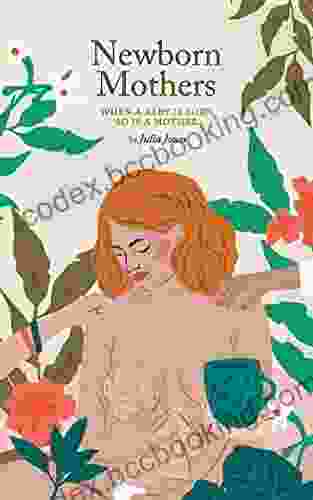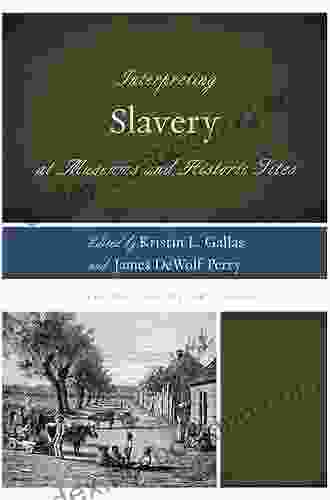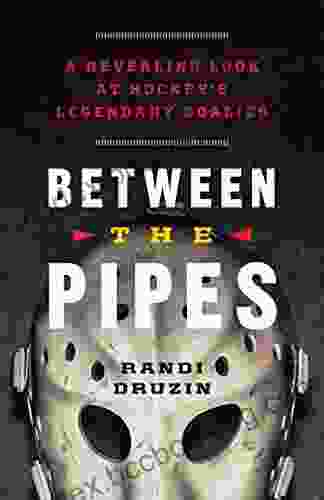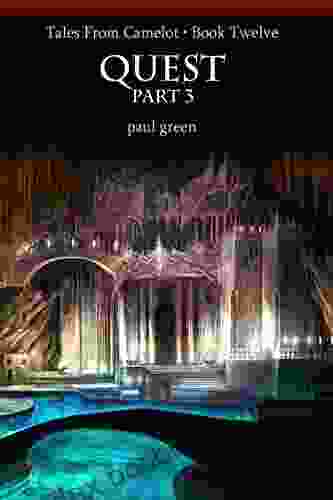Interpreting Slavery at Museums and Historic Sites: Unveiling the Hidden Histories


Museums and historic sites have a profound responsibility to interpret the complex history of slavery in a manner that fosters understanding, empathy, and reconciliation. By presenting diverse perspectives, utilizing innovative exhibition techniques, and engaging visitors in critical thought, institutions can illuminate the multifaceted experiences of enslaved individuals and their impact on our societies today.
4.8 out of 5
| Language | : | English |
| Paperback | : | 160 pages |
| Item Weight | : | 9.5 ounces |
| Dimensions | : | 6 x 0.4 x 9 inches |
| File size | : | 5323 KB |
| Text-to-Speech | : | Enabled |
| Screen Reader | : | Supported |
| Enhanced typesetting | : | Enabled |
| Word Wise | : | Enabled |
| Print length | : | 230 pages |
Unveiling the Hidden Narratives
For centuries, the voices of enslaved individuals were suppressed or erased from historical accounts. Museums and historic sites have a unique opportunity to rectify this historical erasure by giving voice to the experiences, struggles, and triumphs of those who were enslaved. Through immersive exhibits, interactive displays, and oral histories, institutions can reveal the personal stories and lived experiences that have been hidden for so long.
By showcasing the humanity and resilience of enslaved people, museums can challenge prevailing stereotypes and foster a deeper understanding of the systemic racism and dehumanization that fueled the institution of slavery.
Exploring Diverse Perspectives
Interpreting slavery requires acknowledging the diverse perspectives of those involved. This includes the experiences of enslaved individuals, their descendants, slave owners, abolitionists, and those who profited from the slave trade. By presenting multiple viewpoints, museums can help visitors grasp the complex dynamics of slavery and its far-reaching consequences.
Through the inclusion of oral histories, community perspectives, and scholarly research, institutions can create a more comprehensive and nuanced understanding of slavery's impact on all levels of society.
Utilizing Innovative Exhibition Techniques
Modern exhibition techniques offer museums and historic sites a powerful tool to engage visitors in the history of slavery. Interactive displays, immersive multimedia, and digital technologies can bring the past to life and foster a visceral understanding of the institution's horrors.
For example, visitors can use augmented reality to witness firsthand the conditions of slave ships, listen to recordings of spirituals sung by captive Africans, or explore interactive maps that trace the routes of the transatlantic slave trade.
Engaging Visitors in Critical Thought
Interpretation of slavery should not only provide information but also encourage visitors to question their own assumptions and engage in critical thought. By presenting challenging questions, facilitating discussions, and encouraging research, museums can create spaces where visitors can confront their own biases and prejudices.
Through interactive exhibits, guided tours, and educational workshops, institutions can foster meaningful dialogues about the legacy of slavery and its implications for contemporary society.
Interpreting slavery at museums and historic sites is an essential step towards reconciliation and understanding. By unveiling the hidden narratives, exploring diverse perspectives, utilizing innovative exhibition techniques, and engaging visitors in critical thought, institutions can play a pivotal role in shaping the public's understanding of this painful chapter in our history.
Through open and honest dialogue, we can learn from the past, confront systemic racism, and work towards a more just and equitable society.
4.8 out of 5
| Language | : | English |
| Paperback | : | 160 pages |
| Item Weight | : | 9.5 ounces |
| Dimensions | : | 6 x 0.4 x 9 inches |
| File size | : | 5323 KB |
| Text-to-Speech | : | Enabled |
| Screen Reader | : | Supported |
| Enhanced typesetting | : | Enabled |
| Word Wise | : | Enabled |
| Print length | : | 230 pages |
Do you want to contribute by writing guest posts on this blog?
Please contact us and send us a resume of previous articles that you have written.
 Book
Book Novel
Novel Page
Page Chapter
Chapter Text
Text Story
Story Genre
Genre Reader
Reader Library
Library Paperback
Paperback E-book
E-book Magazine
Magazine Newspaper
Newspaper Paragraph
Paragraph Sentence
Sentence Bookmark
Bookmark Shelf
Shelf Glossary
Glossary Bibliography
Bibliography Foreword
Foreword Preface
Preface Synopsis
Synopsis Annotation
Annotation Footnote
Footnote Manuscript
Manuscript Scroll
Scroll Codex
Codex Tome
Tome Bestseller
Bestseller Classics
Classics Library card
Library card Narrative
Narrative Biography
Biography Autobiography
Autobiography Memoir
Memoir Reference
Reference Encyclopedia
Encyclopedia Scoop Malinowski
Scoop Malinowski Olivia Laing
Olivia Laing Ellen Murkison
Ellen Murkison Jon J Muth
Jon J Muth Emma Fick
Emma Fick Kristin Marciniak
Kristin Marciniak Tabatha Yeatts
Tabatha Yeatts Lex Luger
Lex Luger Jeb Rosebrook
Jeb Rosebrook Emily Wilson
Emily Wilson Laura D Rosenthal
Laura D Rosenthal Katrina Mcpherson
Katrina Mcpherson Keisha Brooks
Keisha Brooks Phia Van Der Spuy
Phia Van Der Spuy Emily Levesque
Emily Levesque Emily Haynes
Emily Haynes Emery C F Bryant
Emery C F Bryant Marlo Schalesky
Marlo Schalesky Scott L Collins
Scott L Collins Emma Bland Smith
Emma Bland Smith
Light bulbAdvertise smarter! Our strategic ad space ensures maximum exposure. Reserve your spot today!
 Arthur MasonFollow ·17.1k
Arthur MasonFollow ·17.1k Francis TurnerFollow ·5.6k
Francis TurnerFollow ·5.6k Joseph FosterFollow ·8.2k
Joseph FosterFollow ·8.2k Preston SimmonsFollow ·10.5k
Preston SimmonsFollow ·10.5k Will WardFollow ·10.1k
Will WardFollow ·10.1k Shannon SimmonsFollow ·13.6k
Shannon SimmonsFollow ·13.6k Chase SimmonsFollow ·8.3k
Chase SimmonsFollow ·8.3k Winston HayesFollow ·14k
Winston HayesFollow ·14k

 Isaias Blair
Isaias BlairEscape to Sunrise Cottage: A Captivating Read You Won't...
Are you ready for a...

 Bradley Dixon
Bradley DixonWhen Baby Is Born, So Is Mother: A Comprehensive Guide to...
Giving birth is a...

 Mario Simmons
Mario SimmonsPhotographic Journal of Cruise Around South America: A...
Embark on an Extraordinary Expedition ...

 Langston Hughes
Langston HughesDream Achieved: Unlocking the Power Within to Make Your...
In the tapestry...
4.8 out of 5
| Language | : | English |
| Paperback | : | 160 pages |
| Item Weight | : | 9.5 ounces |
| Dimensions | : | 6 x 0.4 x 9 inches |
| File size | : | 5323 KB |
| Text-to-Speech | : | Enabled |
| Screen Reader | : | Supported |
| Enhanced typesetting | : | Enabled |
| Word Wise | : | Enabled |
| Print length | : | 230 pages |
















